NAVY GLADIATOR REUNION GROUP
USS INTREPID
(CV/CVA/CVS-11)
(CV/CVA/CVS-11)


1968 Cruise
Click on picture to view full size
USS INTREPID
DEPLOYMENTS
The Gladiators of VA-106 made one deployment and a shakedown cruise onboard the USS Intrepid.
1965
The Gladiators of VA-106 found themselves on a Shake-Down Cruise to Guantanamo Bay, Cuba as the Intrepid transitioned to an attack carrier for her next duty assignment. Then in mid-1966, Intrepid joined the Pacific Fleet off the coast of Vietnam.
01 Jun 68 – 08 Feb 69
As Part of Carrier Air Wing 17 (CVW-10), flying the A4E Skyhawk, the Squadron embarked onboard the USS Intrepid (CVS-11) on a WestPac Cruise, for duty in the waters of the Gulf of Tonkin off the coast of Vietnam. Ports visited; Rio de Janeiro, Brazil; Subic Bay, Philippines; Sasebo, Japan; Hong Kong B.C.C.; Singapore; Sydney, Australia; and Wellington, New Zealand.
SIGNIFICENT EVENTS
23 Jul 68
At 11:00pm USS Intrepid entered the combat zone of Yankee Station for the third time. Her mission was to provide air strikes to help cut enemy supply lines to the South. The days were long, the flight deck activities were feverish but the six months on the line passed quickly.
In June of 1968, the Gladiators of Attack Squadron ONE HUNDRED SIX (VA-106) were deployed onboard the USS Intrepid (CVS-11) as part of Carrier Air Wing 10 (CVW-10) bound for the South China Sea. It was there, off the coast of Vietnam that two of our pilots were tragically killed: LCDR David F. Callahan Jr. and LCDR Kenneth Keith Knabb Jr.
USS Intrepid (CV/CVA/CVS-11), also known as The Fighting "I", is one of 24 Essex-class aircraft carriers built during World War II
for the United States Navy. She is the fourth US Navy ship to bear the name. Commissioned in August 1943, Intrepid participated
in several campaigns in the Pacific Theater of Operations, most notably the Battle of Leyte Gulf. Decommissioned shortly after
the end of the war, she was modernized and re-commissioned in the early 1950's as an attack carrier (CVA), and then eventually became
an antisubmarine carrier (CVS).
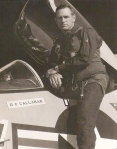
On September 23, 1968, LCDR Callahan launched in his A4E Skyhawk light attack aircraft on a routine mission. He radioed that his generator
had failed and that he was returning to the ship. He was routed for a straight-in approach. He flew the approach well, until in close
to the carrier when the aircraft began to left bank, nose dropping, touching down just short of the landing deck and striking the
Landing Signals Officer (LSO) platform. The aircraft continued to roll left impacting the water in an approximate 90-degree angle.
There was no apparent ejection attempt. LCDR Callahan was listed Killed and his Body not recovered. LCDR Callahan was listed Killed/Body
Not Recovered. His name is listed on the Vietnam Memorial Wall on Panel W43, Line 68.
On October 21, 1968, LCDR Knabb launched on a combat mission into North Vietnam. As he was entering a strafing run from approximately
6,500 feet, a SAM or anti-aircraft fire apparently hit his aircraft. The next sight of his aircraft was as it exploded into a fireball
on the ground. LCDR Knabb's target was about 10 miles southeast of the city of Ha Tinh in the province of the same name. Other pilots
in the flight saw no parachute in the air, but a partially deployed parachute was sighted on the ground in the vicinity of the crash.
No emergency radio beeper signals were heard, and it was unclear whether LCDR Knabb survived. He was placed in Missing in Action Status.
His name is listed on the Vietnam Memorial Wall on Panel 40, Line 13.
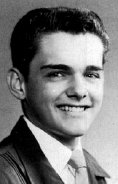
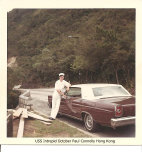
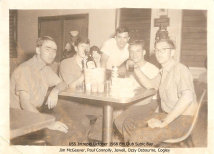
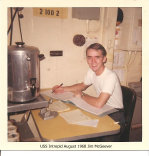
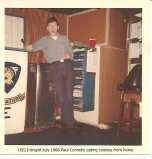
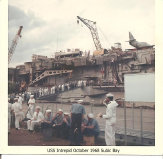
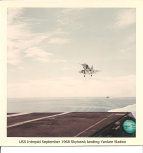
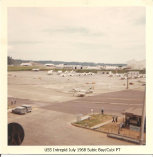
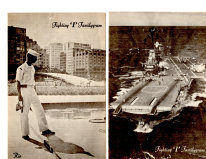
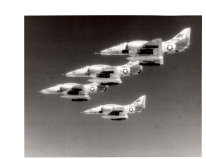
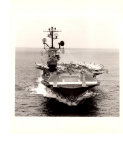
1968 Cruise Book
Click on Link to view Cruise Book
In her second career, she served mainly in the Atlantic, but also participated in the Vietnam War. Her notable achievements
include being the recovery ship for both a Mercury and Gemini space mission. Because of her prominent role in battle,
she was nicknamed "The Fighting I", while her frequent bad luck and time spent in dry dock for repairs - she was torpedoed once and
hit by four separate Japanese kamikaze aircraft - earned her the nicknames "Decrepit" and "The Dry I". She was decommissioned
in 1974 and in 1982 became the foundation of the Intrepid Sea, Air & Space Museum in New York.